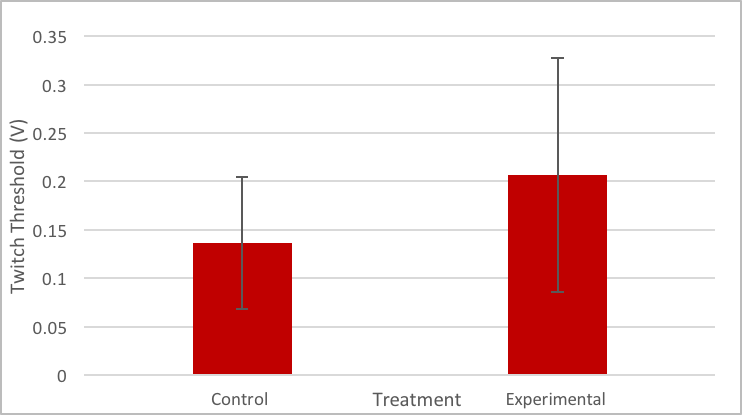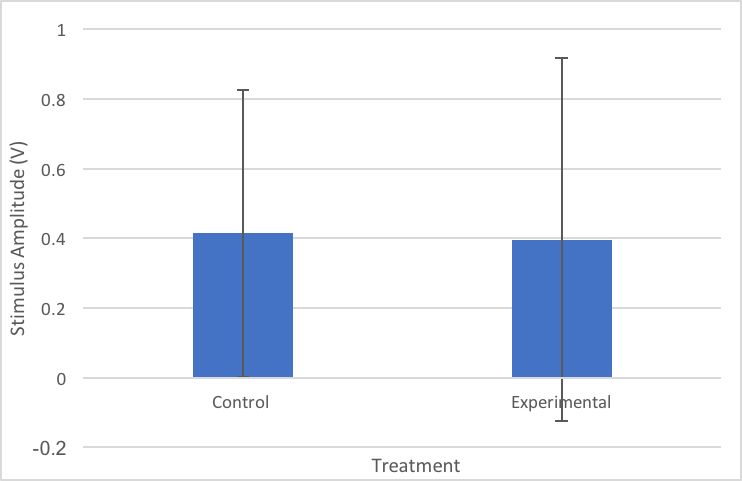Example Report #1
Title
Effect of Lanthanum Chloride (LaCl3) on Twitch Threshold and Stimulus Amplitude of Rana pipens Gastrocnemius Muscle
Abstract
Previous studies have shown that lanthanum binds to Ca+2 binding site blocking the calcium channel, therefore, preventing proper muscle contractions from occurring. 1 mM of LaCl3 was used on Rana pipens legs to block the calcium channels. Increase in twitch threshold and decrease in stimulus amplitude after the injection of the treatment was observed, but were not significant enough to state that there is a difference in mean twitch threshold and stimulus amplitude before and after the treatment. These observations may be due to the low concentration and insufficient time allowed for the treatment to have its effect on the muscle.
Introduction
Organisms use their nervous system to respond to changes in their environment. Their nervous system has the ability to send signals rapidly, produce specific responses, and send action potentials. Action potentials (APs) are electrical signals generated in the motor neurons of the spinal cord and travel though neuromuscular junctions. When an AP arrives at a neuromuscular junction, depolarization occurs causing the release of acetylcholine (ACh), a neurotransmitter commonly found in muscles, from the presynaptic nerve terminal. ACh diffuses and binds to the receptors on the muscle fiber causing sodium (Na+) channels to open and generate an AP in the muscle fiber. The AP spreads along the muscle fiber causing the release of calcium ions (Ca+2) from the sarcoplasmic reticulum (SR). The release of Ca²⁺ causes the muscle to contract [Johnson: 2016].
Rabbit aortic smooth muscle exposed to 1.5 mM of lanthanum ion (La+3) was found to have La+3 bind to the Ca+2 binding sites instead of Ca+2, therefore preventing the “rebinding and reuptake of Ca+2” and inhibiting proper muscle contractions [Goodman: 1971].
Rana pipiens legs consists of the sciatic nerve and the gastrocnemus muscle. When the sciatic nerve is stimulated or when the gastrocnemus muscle is stimulated, the twitch response of the gastrocnemus muscle is visible, making the Rana pipiens a suitable organism for this experiment.
In our experiment, we examined the effects of lanthanum chloride (LaCl3), a calcium channel blocker [Johnson: 2016], on the muscular response of the Rana pipiens legs. We hypothesize that, if 1 mM of LaCl3 is injected into the Rana pipiens leg, then the twitch amplitude and the stimulus amplitude applied to its nerve will be weaker.
Materials and Methods
For this experiment, three Rana pipiens legs were obtained and maintained on ice. The skin of the Rana pipiens leg was pulled back to reveal the muscles underneath. The sciatic nerve was carefully exposed and separated from the connective tissues of the inner thigh muscles. The gastrocnemus muscle was separated from the tibialis anterior and cut at the Achilles tendon. The Achilles tendon was then tied to a string and suspended to the force transducer (FT302) of the iWorx electrophysiology (EP) recording equipment. The sciatic nerve was placed on the sleeve probe and covered with a rubber sleeve. Ringer’s solution was used throughout the experiment when need to maintain the moisture of the legs.
The iWorx software was used to measure the twitch threshold and the stimulus amplitude. For each of the three legs, the stimulus amplitude was first set to 0.1V and increased in 0.1V increments until a muscle twitch was detected. The stimulus amplitude was then increased or decreased in 0.01V increments until the twitch threshold was determined. The twitch threshold and the stimulus amplitude applied to the nerve was then recorded.
The same three Rana pipiens legs were then injected with 0.2 ml of 1mM LaCl3 into the gastrocnemus muscle and given approximately 10 minutes to spread through the muscle. The same method of measuring the twitch threshold and stimulus amplitude used before the injection was used after the injection.
The results were analyzed using the paired t-test.
Results
There was an increase in the mean twitch threshold after the injection of LaCl3 in the Rana pipiens legs (Figure 1). There was a decrease in the mean stimulus amplitude after the injection of LaCl3 in the Rana pipiens legs (Figure 2). The twitch threshold and stimulus amplitude for all the legs were recorded based on the twitch observed on the gastrocnemus muscle, but twitch was observed in the lower portion of the legs after injection.
There is no significant difference in the mean twitch threshold of the Rana pipiens leg before and after the injection of lanthanum chloride (Figure 1, t-stat = 1.85, d.f. = 2, P = 0.206). There is also no significant difference in the mean stimulus amplitude applied to the nerve of the Rana pipiens leg before and after the injection of lanthanum chloride (Figure 2, t-stat = 0.232, d.f. = 2, P = 0.838).
Discussion
Based on our observations and statistical testing, we reject our hypothesis which stated that, if 1 mM of LaCl3 is injected into the Rana pipiens leg, then the twitch amplitude and the stimulus amplitude applied to its nerve will be weaker, and, instead, support our null hypothesis.
Although LaCl₃ may have the effect of weakening muscle contraction, as seen in a previous experiment with the use of La3+ ion [Goodman: 1971], in our experiment, there was no significant difference in the mean twitch threshold and mean stimulus amplitude applied to the nerve between the control and the treatment. This contrast in results may have been due to the fact that the concentration of LaCl3 was too low or the amount of time for the treatment to be absorbed by the muscle was insufficient for blocking calcium channels. In the experiment performed by Goodman, 1.5 mM of La3+ was used [Goodman: 1971], whereas, in our experiment, 1.0 mM of LaCl₃ was used. Goodman’s use of a higher concentration of La3+, as opposed to our use of a lower concentration of LaCl3 may have contributed to the observation. In a future experiment, we would like to increase the concentration of LaCl3 and also increase the amount of time allowed for the treatment to have its effects on blocking the calcium channels.
Literature Cited
- Johnson AD. Neuromuscular Control. Biological Principles Laboratory Manual. Dept. Biology, Wake Forest University, Winston-Salem, NC. Vers. 16.1 (updated May 1, 2016), pp. 19-35.
- Goodman FR. & Weiss GB. 1971. Effects of lanthanum on 45Ca movements and on contractions induced by norepinephrine, histamine and potassium in vascular smooth muscle. Journal of Pharmacology and Experimental Therapeutics. 177(2): 415-425.
Notes For Instructors
This particular report is a good example of how a report can be good overall, yet still have points where it could be improved.
Primary Points to Focus On First
- This report does a good job integrating prior observations from [Goodman: 1971]. A more recent source would have been better.
- Both the Results section and the figure legends have reported the statistical results correctly.
- The report would benefit from additional primary sources to support an explanation or argument why their original hypothesis did not match their observations.
Other Points of Concern
- The Introduction makes broad over-generalizations about neuromuscular physiology. The system in vertebrates is not the same as the one in invertebrates.
- Methods section could be condensed and streamlined.

